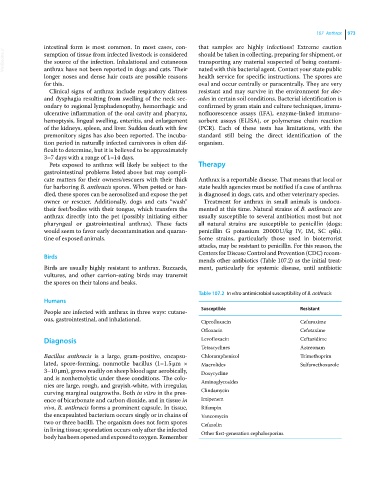Page 1035 - Clinical Small Animal Internal Medicine
P. 1035
107 Anthrax 973
intestinal form is most common. In most cases, con- that samples are highly infectious! Extreme caution
VetBooks.ir sumption of tissue from infected livestock is considered should be taken in collecting, preparing for shipment, or
transporting any material suspected of being contami-
the source of the infection. Inhalational and cutaneous
anthrax have not been reported in dogs and cats. Their
health service for specific instructions. The spores are
longer noses and dense hair coats are possible reasons nated with this bacterial agent. Contact your state public
for this. oval and occur centrally or paracentrally. They are very
Clinical signs of anthrax include respiratory distress resistant and may survive in the environment for dec-
and dysphagia resulting from swelling of the neck sec- ades in certain soil conditions. Bacterial identification is
ondary to regional lymphadenopathy, hemorrhagic and confirmed by gram stain and culture techniques, immu-
ulcerative inflammation of the oral cavity and pharynx, nofluorescence assays (IFA), enzyme‐linked immuno-
hemoptysis, lingual swelling, enteritis, and enlargement sorbent assays (ELISA), or polymerase chain reaction
of the kidneys, spleen, and liver. Sudden death with few (PCR). Each of these tests has limitations, with the
premonitory signs has also been reported. The incuba- standard still being the direct identification of the
tion period in naturally infected carnivores is often dif- organism.
ficult to determine, but it is believed to be approximately
3–7 days with a range of 1–14 days.
Pets exposed to anthrax will likely be subject to the Therapy
gastrointestinal problems listed above but may compli-
cate matters for their owners/rescuers with their thick Anthrax is a reportable disease. That means that local or
fur harboring B. anthracis spores. When petted or han- state health agencies must be notified if a case of anthrax
dled, these spores can be aerosolized and expose the pet is diagnosed in dogs, cats, and other veterinary species.
owner or rescuer. Additionally, dogs and cats “wash” Treatment for anthrax in small animals is undocu-
their feet/bodies with their tongue, which transfers the mented at this time. Natural strains of B. anthracis are
anthrax directly into the pet (possibly initiating either usually susceptible to several antibiotics; most but not
pharyngeal or gastrointestinal anthrax). These facts all natural strains are susceptible to penicillin (dogs:
would seem to favor early decontamination and quaran- penicillin G potassium 20 000 U/kg IV, IM, SC q4h).
tine of exposed animals. Some strains, particularly those used in bioterrorist
attacks, may be resistant to penicillin. For this reason, the
Centers for Disease Control and Prevention (CDC) recom-
Birds
mends other antibiotics (Table 107.2) as the initial treat-
Birds are usually highly resistant to anthrax. Buzzards, ment, particularly for systemic disease, until antibiotic
vultures, and other carrion‐eating birds may transmit
the spores on their talons and beaks.
Table 107.2 In vitro antimicrobial susceptibility of B. anthracis
Humans
People are infected with anthrax in three ways: cutane- Susceptible Resistant
ous, gastrointestinal, and inhalational. Ciprofloxacin Cefuroxime
Ofloxacin Cefotaxime
Diagnosis Levofloxacin Ceftazidime
Tetracyclines Aztreonam
Bacillus anthracis is a large, gram‐positive, encapsu- Chloramphenicol Trimethoprim
lated, spore‐forming, nonmotile bacillus (1–1.5 μm × Macrolides Sulfamethoxazole
3–10 μm), grows readily on sheep blood agar aerobically, Doxycycline
and is nonhemolytic under these conditions. The colo- Aminoglycosides
nies are large, rough, and grayish‐white, with irregular,
curving marginal outgrowths. Both in vitro in the pres- Clindamycin
ence of bicarbonate and carbon dioxide, and in tissue in Imipenem
vivo, B. anthracis forms a prominent capsule. In tissue, Rifampin
the encapsulated bacterium occurs singly or in chains of Vancomycin
two or three bacilli. The organism does not form spores Cefazolin
in living tissue; sporulation occurs only after the infected Other first‐generation cephalosporins
body has been opened and exposed to oxygen. Remember

